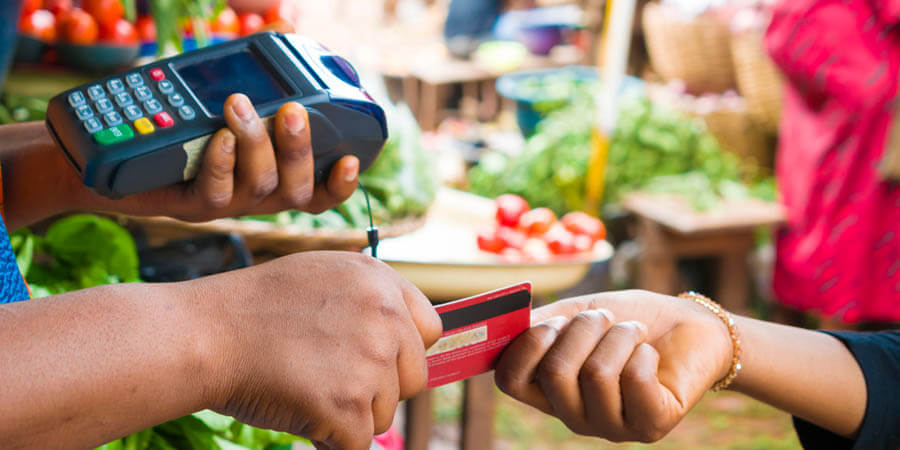Since the debut of the first plastic credit card in 1959, payment technology has evolved rapidly. Magnetic stripe payments held power for three decades, from the '70s to the '90s, followed by the advent of EMV chip card technology in the mid-'90s. In Africa, the retail landscape is transforming by integrating contactless payments and mobile money. Many countries on the continent are witnessing a surge in consumers adopting these methods for transactions. As electronic payments gain momentum, traditional cash is being edged out, and cryptocurrencies and digital currencies are emerging as alternative transaction options.
The Covid-19 pandemic accelerated the demand for contactless payments, turning them into an essential feature. Forward-thinking small business owners must stay informed about these changes.
Cashless and contactless payments, though often used interchangeably, differ in their methodologies. Contactless payments involve transactions made using contactless debit, credit cards, or mobile phones equipped with Radio Frequency Identification (RFID) technology. Users must bring the card or device near the vendor's contactless payment-enabled terminal, initiating a connection signaled by a beep, green light, or checkmark before completing the transaction. Notably, services like Apple Pay, Google Play, and Tap to Pay tokenize payment cards, transferring information to the vendor's device without directly authorizing transactions. However, cashless payments encompass a broader spectrum, including not only contactless payments but also web-based methods like bank transfers, mobile payments, payment apps, and digital wallets.
Cashing Out: The Ups and Downs
The adoption of cashless transactions, including contactless payments and mobile money, presents a range of advantages and drawbacks in the modern financial landscape. Contactless payments are praised for their convenience and heightened security compared to traditional magnetic strip cards, as the encrypted information exchanged during transactions makes it challenging for fraudsters to intercept or steal data. Documented transactions provide transparency for both consumers and businesses, while vendors benefit from reduced on-site cash, minimizing security risks. Cashless payments, including money transfers, extend these advantages globally, simplifying international transactions and eliminating the need for currency exchanges, thereby saving users money on storage and deposits.
In contrast, the shift towards a cash-free society is not without its downsides. Privacy concerns, hacking threats, and payment fraud persist as significant challenges. Some contactless cards and devices employ questionable security measures, relying on PIN input only for high-value transactions. This allows potentially repetitive low-value transactions to go unnoticed. The cybersecurity threat intensifies with online payment avenues, leading to inconsistent security measures and reliance on electricity and connectivity, which can be problematic in regions with limited infrastructure, especially rural areas in Africa. Additionally, the processing costs associated with cashless transactions may prove prohibitive for small businesses.
Is Africa Ready to Go Cashless?
Mobile money is gaining widespread acceptance in Africa, particularly in Sub-Saharan Africa, where 144 mobile money providers are at the forefront of transforming consumer transactions. Notably, key players such as M-Pesa (by Safaricom), MoMo (by MTN), and Orange Money dominate the market share, as reported by Statista.
Telecommunication companies are leading the charge in providing mobile money services, supported by a network of licensed agents. These services empower registered users to deposit cash into a virtual wallet, utilizing the funds for various payments and purchases, including peer-to-peer (P2P) transactions.
Recent data from GSMA underscored the significant growth of mobile money in Africa. The number of registered mobile money accounts surged by 12% to reach 562 million in 2020, with monthly active accounts experiencing an impressive 18% increase to reach 161 million. The total number of transactions reached 27.5 billion, marking a 15% increase, and their total value amounted to $495 billion, reflecting a substantial 23% rise. Notably, the region boasts 171 active mobile money services, as reported by GSMA, indicating the expanding influence and acceptance of mobile money in the African financial landscape.
Furthermore, as the momentum of cashless and contactless payments continues to reshape financial landscapes, a closer look at Morocco, Kenya, Nigeria, and Senegal reveals distinctive trends and challenges in their respective journeys toward digital transactions.
Nigeria, while still predominantly cash-based, is witnessing a shift towards credit cards and mobile money apps. The government's encouragement of digital transactions aligns with the recorded surge in point-of-sale (POS) transactions, reaching over 655 million valued at $13 billion in 2020, according to the Nigeria Inter-Bank Settlement System (NIBSS). The rising availability of 4G networks and smartphones is further catalyzing this transformation, with smaller retailers leveraging social media channels for sales.
Kenya emerges as a digital payment trailblazer in Africa, with a staggering 94% of the population using mobile money, notably led by the success story of M-PESA. Serving over 32.1 million users in Kenya and 60 million across eight African markets, M-Pesa is partnering with Visa to introduce tap-to-pay capabilities. The expansion follows the successful launch of the M-Pesa GlobalPay Visa Virtual Card, enabling secure international shopping. With recent PCI DSS Certification, M-Pesa's tap-to-pay solution ensures seamless transactions for customers and facilitates effortless payments for merchants. This strategic move positions M-Pesa to enter the cash-centric retail sector, offering visitors card payment options. The collaboration with Visa not only strengthens M-Pesa's industry standing but also envisions fintech leveraging its card processing capabilities for comprehensive mobile and card payment solutions across eight countries.
Morocco showcases a growing acceptance of online payments, with 67% of online consumers opting for digital bill payments. The Mastercard New Payments Index in 2022 reveals that 76% of Moroccans utilized emerging payment methods, including digital money transfer apps and smartphone mobile wallets. However, the adoption of mobile money remains modest, with just 6% of Moroccans having mobile money accounts in 2021, according to the World Bank.
In Senegal, the digital payments landscape is marked by a significant shift, as nearly 40% of the population embraced digital payments between 2021 and 2022. Mobile money payments play a vital role, with 31.8% of consumers having mobile money accounts, a noteworthy figure considering that only 20.4% have accounts with traditional financial institutions. The market leader, Wave, processes billions of dollars in annual volume and has strategic partnerships with UBA and Ecobank for its operations in Senegal.
In these diverse contexts, businesses play a pivotal role in fostering trust and adoption of cashless and contactless payments, emphasizing the importance of robust security measures, especially in regions where the transition is still in its early stages.








